Semantic Fusion of Health Data: Implementing a Federated Virtualized Knowledge Graph Framework Leveraging Ontop System
Abstract
1. Introduction
2. Theoretical Background
2.1. Ontology-Based Design Science Research (ODSR) Framework in Health Information Systems
2.2. The Virtual Knowledge Graph Framework
2.3. Virtual Knowledge Graph Mapping and Tooling Ecosystem
3. Methodology
3.1. Ontology-Based Design Science Research Engineering (ODSRE) Methodology
3.2. Activities 1 and 2: Problem Investigation and Motivation for Heterogeneous Data Collection—Construct Artifact
3.3. Activity 3: Defining the Objectives, Definition, and Relevance
Data Analysis
3.4. Activity 4: Construction of Federated Virtual Knowledge Graph (FVKG) Framework—Architectural Artifact
3.4.1. Architectural Flexibility vs. Complexity
3.4.2. Modularization Strategies
3.4.3. Automation Tools
3.4.4. Best Practice Recommendations
3.4.5. Selection of Ontop Platform Dependency
4. Experimental Results
4.1. Constructing a Virtual Semantic View (VSV) for Federated Ontology
4.2. Domain-Oriented Ontological Model and Data Visualization Artifact
4.3. A Systematic Process for Federated Virtual Knowledge Graph (FVKG) Generation
4.4. Inputs to Build VKGs: Ontology, Mappings, Queries, Databases, and Ontop
4.4.1. Ontology
4.4.2. SPARQL Queries and Mappings
4.4.3. Databases
4.4.4. Ontop Core
4.5. Using Ontop Virtual Platform as Transformation Mapping Artifact for Data Integration and Data Interoperability Management
5. Evaluation and Testing
5.1. Ontological Model Testing to Verify Competence Questions Using DL in Protege
5.2. Data Integration and Interoperability Tests Using Ontop SPARQL Endpoint to Evaluate Federated VKG
5.3. Comparative Synthesis with Existing Approaches: Ontop and SQL for Data Retrieval with Time over Databases
5.4. Ontop SPARQL Endpoint with Ontop CLI
6. Conclusions and Future Directions
Limitations and Future Validation
Author Contributions
Funding
Data Availability Statement
Conflicts of Interest
References
- Hilbert, M.; Lopez, P. The World’s technological capacity to store, communicate, and compute. Inf. Sci. 2011, 332, 60–65. [Google Scholar] [CrossRef]
- Gu, Z.; Corcoglioniti, F.; Lanti, D.; Mosca, A.; Xiao, G.; Xiong, J.; Calvanese, D. A systematic overview of data federation systems. Semant. Web 2024, 15, 107–165. [Google Scholar] [CrossRef]
- Reinsel, D.; Gantz, J.; Rydning, J. The Digitization of the World from Edge to Core, International Data Corporation; Technical Report; International Data Corporation: Framingham, MA, USA, 2018. [Google Scholar]
- Fareedi, A.A.; Ismail, M.; Ghazawneh, A.; Ahmed, S.; Bukhari, S.A.C. Empowering health data fusion: A federated virtual knowledge graph approach leveraging the Ontop platform. In Proceedings of the 16th Mediterranean Conference on Information Systems (MCIS 2024) and the 24th Conference of the Portuguese Association for Information Systems (CAPSI 2024), Porto, Portugal, 3–5 October 2024; pp. 1–17. [Google Scholar]
- Hammond, W.E.; Bailey, C.; Boucher, P.; Spohr, M.; Whitaker, P. Connecting information to improve health. Health Aff. 2010, 29, 285–290. [Google Scholar] [CrossRef][Green Version]
- Gosh, B.; Scott, J.E. A grounded theory investigation into data interoperability in healthcare. In Proceedings of the Pacific Asia Conference on Information Systems (PACIS), Ho Chi Minh City, Vietnam, 11–15 July 2012; pp. 1–14. [Google Scholar]
- Schwade, F.; Schubert, P. A semantic data lake for harmonizing data from cross-platform digital work spaces using ontology-based data access. In Proceedings of the Americas Conference on Information Systems (AMCIS), Virtual, 15–17 August 2020; pp. 1–10. [Google Scholar]
- Beyer, M.A.; Thoo, E.; Zaidi, E. Magic Quadrant for Data Integration Tools; Technical Report ID-G00340493; Gartner: Stamford, CT, USA, 2018. [Google Scholar]
- Vasiliev, D.A.; Ghiran, A.M.; Buchmann, R.A. Data federation for a project management solution through a GraphQL middleware. In Proceedings of the 29th International Conference on Information Systems Development (ISD2021), Valencia, Spain, 8–10 September 2021; pp. 1–12. [Google Scholar]
- GraphQL. GraphQL Specifications. 2018. Available online: https://spec.graphql.org/June2018/ (accessed on 8 May 2024).
- Cyganiak, R.; Wood, D.; Lanthaler, M. RDF 1.1 Concepts and Abstract Syntax. 2014. Available online: https://www.w3.org/TR/rdf11-concepts/ (accessed on 8 May 2024).
- Hakimpour, F.; Geppert, A. Resolving semantic heterogeneity in schema integration: An ontology based approach. In Proceedings of the Formal Ontology in Information Systems (FOIS): Collected Papers from the Second International Conference, Ogunquit, ME, USA, 17–19 October 2001; pp. 297–308. [Google Scholar]
- Grangel-Gonzalez, I.; Losch, F.; Mehdi, M.A.U. Knowledge graphs for efficient integration and access for manufacturing data. In Proceedings of the 25th IEEE International Conference on Emerging Technologies and Factory Automation (ETFA), Vienna, Austria, 10–13 September 2020; pp. 1–8. [Google Scholar]
- Studer, R.; Benjamins, V.R.; Fensel, D. Knowledge engineering: Principles and methods. Data Knowl. Eng. 1998, 25, 161–197. [Google Scholar] [CrossRef]
- Gagnon, M. Ontology-based integration of data sources. In Proceedings of the 10th International Conference on Information Fusion, Québec, QC, Canada, 9–12 July 2007; pp. 1–8. [Google Scholar]
- Konstantinou, N.; Spanos, D.E.; Mitrou, N. Ontology and database mapping: A survey of current implementations and future directions. J. Web Eng. 2008, 7, 001–024. [Google Scholar]
- Xiao, G.; Calvanese, D.; Kontchakov, R.; Lembo, D.; Poggi, A.; Rosati, R.; Zakharyaschev, M. Ontology-based data access: A survey. In Proceedings of the Twenty-Seventh International Joint Conference on Artificial Intelligence (IJCAI-18), Stockholm, Sweden, 13–19 July 2018; pp. 1–9. [Google Scholar]
- Calvanese, D.; De Giacomo, G.; Lembo, D.; Lenzerini, M.; Poggi, A.; Rodriguez-Muro, M.; Rosati, R.; Ruzzi, M.; Savo, D.F. The MASTRO system for ontology-based data access. Semant. Web 2011, 2, 43–53. [Google Scholar] [CrossRef]
- Nguyen, A.; Gardner, L.; Sheridan, D. Towards ontologyb-based design science research for knowledge accumulation and evolution. In Proceedings of the 52nd Hawaii International Conference on System Science, Maui, HI, USA, 8–11 January 2019; pp. 1–10. [Google Scholar]
- Song, F.; Zacharewicz, G.; Chen, D. An ontology-driven framework towards building enterprise semantic integration layer. Adv. Eng. Inform. 2013, 27, 38–50. [Google Scholar] [CrossRef]
- Ostrowski, L.; Helfert, M.; Gama, N. Ontology engineering step in design science research methodology: A technique to gather and reuse knowledge. Behav. Inf. Technol. 2014, 33, 443–451. [Google Scholar] [CrossRef]
- Reiterer, E.; Venable, J.R. Ontological support for the use of design science research results. In Proceedings of the International Conference on Design Science Research in Information Systems and Technology (DESRIST), DESRIST 2016, St. John’s, NL, Canada, 24–25 May 2016; pp. 75–82. [Google Scholar]
- Reiterer, E.; Venable, J.R.; Reiners, T. Ontological representation of design science research publications. In Proceeding of the DESRIST, Dublin, Ireland, 20–22 May 2015; pp. 125–126. [Google Scholar]
- Hevner, A.; March, S.T.; Park, J. Design science in information systems research. MIS Qual. 2004, 28, 75–105. [Google Scholar] [CrossRef]
- Li, Z.; Raskin, V.; Ramani, K. A methodology of engineering ontology development for information retrieval. In Proceeding of the International Conference on Engineering Design, Paris, France, 28–31 July 2007; pp. 1–12. [Google Scholar]
- Uschold, M.; King, M. Towards a methodology for building ontologies. In Proceedings of the IJCAI95 Workshop on Basic Ontological Issues in Knowledge Sharing, Edinburg, UK, 19–20 August 1995; pp. 1–15. [Google Scholar]
- Nguyen, A.; Gardner, L.; Sheridan, D. Building an ontology of learning analytics. In Proceeding of the Pacific Asia Conference on Information Systems (PACIS), Yokohama, Japan, 26–30 June 2018; pp. 1–16. [Google Scholar]
- Raad, J.; Cruz, C. A Survey on ontology evaluation methods. In Proceedings of the 7th International Joint Conference on Knowledge Discovery, Knowledge Engineering and Knowledge Management, SCITEPRESS—Science and Technology Publications, Lisbon, Portugal, 12–14 November 2015; pp. 179–186. [Google Scholar]
- Xiao, G.; Ding, L.; Cogrel, B.; Calvanese, D. Virtual knowledge graphs: An overview of systems and use cases. Data Intell. 2019, 1, 201–223. [Google Scholar] [CrossRef]
- Jayadianti, H.; Pinto, C.S. Solving problems of data heterogeneity, semantic heterogeneity and data inequality—An Approach using ontologies. In Proceedings of the Mediterranean Conference on Information Systems (MCIS), Guimarães, Portugal, 8–10 September 2012; pp. 1–14. [Google Scholar]
- Torab-Miandoab, A.; Samad-Soltani, T.; Jodati, A.; Rezael-Hachesu, P. Interoperability of heterogeneous health information systems: A systematic literature review. BMC Med. Inform. Decis. Mak. 2023, 23, 18. [Google Scholar] [CrossRef] [PubMed]
- De Mello, B.H.; Rigo, S.J.; da Costa, C.A.; Righi, R.d.R.R.; Donida, B.; Bez, M.R.; Schunke, L.C. Semantic interoperability in health records standards: A systematic literature review. Health Technol. 2022, 12, 255–272. [Google Scholar] [CrossRef] [PubMed]
- Yuwen, S.; Yang, X. Research on the clinical terminology construction based on SNOMED. In Proceeding of the Seventh International Conference on Fuzzy Systems and Knowledge Discovery, Yantai, China, 10–12 August 2010; pp. 1–5. [Google Scholar]
- Ben Hamouda, I.; Tantan, O.C.; Boughzala, I. Towards an ontological framework for knowledge sharing in healthcare systems. In Proceedings of the Pacific Asia (PACIS), Chiayi, Taiwan, 27 June–1 July 2016; pp. 1–9. [Google Scholar]
- Brut, M.; Al-Kukhun, D.; Péninou, A.; Canut, M.-F.; Sèdes, F. Structuration et Accès au Dossier Patient Médical Personnel: Approche par ontologie et politique d’accès XACML. In Proceedings of the 1ère édition du Symposium sur l’Ingénierie de l’Information Médicale, SIIM 2011, Toulouse, France, 9–10 June 2011. [Google Scholar]
- Poggi, A.; Lembo, D.; Calvanese, D.; De Giacomo, G.; Lenzerini, M.; Rosati, R. Linking data to ontologies. J. Data Semant. 2008, 10, 133–173. [Google Scholar]
- Denodo Technologies. Denodo Fearless Data. 2024. Available online: https://www.denodo.com/en (accessed on 8 May 2024).
- Dremio Technologies. Dremio: The Unified Lakehouse Platform for Self-Service Analytics and AI. 2024. Available online: https://www.dremio.com/ (accessed on 8 May 2024).
- Teiid Technologies. Teiid: Cloud-Native Data Virtualization. 2024. Available online: https://teiid.io/ (accessed on 8 May 2024).
- Dahlberg, T.; Lagstedt, A.; Nokka, T. How to address master data complexity in information systems development—A federative approach. In Proceedings of the European Conference of Information Systems (IS2018), Portsmouth, UK, 23–28 June 2018; pp. 1–16. [Google Scholar]
- Fletcher, G.H.L.; Hidders, J.; Larriba-Pey, J.L. Graph Data Management, Fundamental Issues and Recent Developments, 1st ed.; Springer: Cham, Switzerland, 2018; pp. 1–32. [Google Scholar]
- Borgida, A.; Brachman, R.J. Conceptual Modeling with Description Logics. In The Description Logic Handbook: Theory, Implementation and Applications; Cambridge University Press: Cambridge, UK, 2003. [Google Scholar]
- Xiao, G.; Kontchakov, R.; Cogrel, B.; Calvanese, D.; Botoeva, E. Efficient handling of SPARQL OPTIONAL for OBDA. In Proceeding of the ISWC, Monterey, CA, USA, 8–12 October 2018; pp. 354–373. [Google Scholar]
- Harris, S.; Seaborne, A. SPARQL 101 Query Language. 2013. Available online: https://www.w3.org/TR/sparql11-query/ (accessed on 8 May 2024).
- Guarino, N.; Welty, C.A. An overview of OntoClean. In Handbook on Ontologies, International Handbooks on Information Systems; Staab, S., Studer, R., Eds.; Springer: Berlin, Germany, 2009. [Google Scholar]
- Bizer, C.; Cyganiak, R. D2RQ—Lessons learned. In Proceedings of the W3C Workshop on RDF Access to Relational Databases, W3C, Cambridge, MA, USA, 25–26 October 2007. [Google Scholar]
- Priyatna, F.; Corcho, Ó.; Sequeda, J.F. Formalisation and experiences of R2RML based SPARQL to SQL query translation using Morph. In Proceedings of the 23rd International World Wide Web Conference (WWW), ACM, Seoul, Republic of Korea, 7–11 April 2014; pp. 479–490. [Google Scholar]
- Calvanese, D.; Cogrel, B.; Komla-Ebri, S.; Kontchakov, R.; Lanti, D.; Rezk, M.; Rodriguez-Muro, M.; Xiao, G. Ontop: Answering SPARQL queries over relational databases. Semant. Web 2017, 8, 471–487. [Google Scholar] [CrossRef]
- Oracle. Spatial Database. 2024. Available online: https://www.oracle.com/database/spatial/ (accessed on 8 May 2024).
- Stardog. Virtaul Graphs in Stardog. 2024. Available online: https://www.stardog.com/blog/virtual-graphs-in-stardog-5 (accessed on 8 May 2024).
- Sequeda, J.F.; Miranker, D.P. Ultrawrap: SPARQL execution on relational data. J. Web Semant. 2013, 22, 19–39. [Google Scholar] [CrossRef]
- Das, S.; Sundara, S.; Cyganiak, R. R2RML: RDB to RDF Mapping Language. 2012. Available online: https://www.w3.org/TR/r2rml/ (accessed on 8 May 2024).
- Sicilia, A.; Nemirovski, G.; Nolle, Á. Map-On: A web-based editor for visual ontology mapping. Semant. Web 2017, 8, 969–980. [Google Scholar] [CrossRef]
- Heyvaert, P.; Dimou, A.; De Meester, B.; Seymoens, T.; Herregodts, A.L.; Verborgh, R.; Schuurman, D.; Mannens, E. Specification and implementation of mapping rule visualization and editing: MapVOWL and the RMLEditor. J. Web Semant. 2018, 49, 31–50. [Google Scholar] [CrossRef]
- RMLIO Technologies. Easily Generate High-Quality Knowledge Graphs with RML.io. 2024. Available online: https://rml.io/ (accessed on 8 May 2024).
- Blinkiewicz, M.; Bak, J. SQuaRE: A visual approach for ontology-based data access. In Proceedings of the 6th Joint International Conference on Semantic Technology (JIST2016), Singapore, 2–4 November 2016; Springer: Berlin/Heidelberg, Germany, 2016; pp. 47–55. [Google Scholar]
- Wieringa, R.J. Design Science Methodology for Information Systems and Software Engineering; Springer: Berlin/Heidelberg, Germany, 2014. [Google Scholar]
- Simpert, E.; Tempich, C.D. Ontology engineering: A reality check. In Proceedings of the Move to Meaningful Internet Systems 2006: CoopIS, DOA, GADA, and ODBASE, OTM Confederated International Conferences, Montpellier, France, 29 October–3 November 2006; pp. 836–854. [Google Scholar]
- Muller, R.M.; Thoring, K. Understanding artifact knowledge in design science: Prototype and products as knowledge repositories. In Proceedings of the Seventeenth Americas Conference on Information Systems (ACIS), Detroit, MI, USA, 4–8 August 2011; pp. 1–10. [Google Scholar]
- Fareedi, A.A.; Tarasov, V. Modelling of the ward round process in a healthcare unit. In Proceedings of the Practice of Enterprise Modeling: 4th IFIP WG 8.1 Working Conference, PoEM, Oslo, Norway, 2–3 November 2011; pp. 223–237. [Google Scholar]
- Prat, N.; Comyn-Wattiau, I.; Akoka, J. Artifact evaluation in information systems design science research—A holistic view. In Proceedings of the Pacific Asia Conference on Information Systems (PACIS 2014), Chengdu, China, 24–28 June 2014; pp. 1–16. [Google Scholar]
- Gómez-Pérez, A.; Fernández-López, M.; Corcho, O. Ontological Engineering, 1st ed.; Springer: Berlin/Heidelberg, Germany, 2003; pp. 1–412. [Google Scholar]
- Fernández-López, M.; Gómez-Pérez, A.; Juristo, N. Methontology: From Ontological Art Towards Ontological Engineering. In Proceedings of the Ontological Engineering AAAI-97 Spring Symposium Series, Standford University, EEUU, Stanford, CA, USA, 24–26 March 1997. [Google Scholar]
- Noy, N.; McGuinness, D.L. Ontology Development 101; Knowledge Systems Laboratory, Stanford University: Stanford, CA, USA, 2001. [Google Scholar]
- Fareedi, A.A. Ontology-Based Model for the “Ward-Round” Process in Healthcare (OMWRP). Master’s Thesis, Tekniska Hogskolan I Jonkoping University, Jönköping, Sweden, 2010. [Google Scholar]
- Ulianova, S. Cardiovascular Disease Dataset. 2019. Available online: https://www.kaggle.com/datasets/sulianova/cardiovascular-disease-dataset/code (accessed on 8 May 2024).
- Mogotlane, D.K.; Fonou-Dombeu, J.V. Automatic conversion of relational databases into ontologies: A comparative analysis of protege plug-ins performances. Int. J. Web Semant. Technol. 2016, 7, 21–40. [Google Scholar] [CrossRef]
- Telnarova, Z. Relational database as a source of ontology creation. In Proceedings of the International Multi-Conference on Computer Science and Information Technology, Wisla, Poland, 18–20 October 2010; pp. 135–139. [Google Scholar]
- Brickley, D.; Guha, R.V. RDF Vocabulary Description Language 1.0: RDF Schema. W3C Recommendation, World Wide Web Consortium. February 2004. Available online: https://www.w3.org/TR/rdf-schema/ (accessed on 27 November 2024).
- Xiao, G.; Rezk, M.; Rodriguez-Muro, M.; Calvanese, D. Rules and ontology based data access. In Proceedings of the 8th International Conference on Web Reasoning and Rule Systems (RR), Volume 8741 of Lecture Notes in Computer Science, Athens, Greece, 15–17 September 2014; Springer: Berlin/Heidelberg, Germany, 2014; pp. 157–172. [Google Scholar]
- Tsangaris, M.M.; Kakaletris, G.; Kllapi, H.; Papanikos, G.; Pentaris, F.; Polydoras, P.; Sitaridi, E.; Stoumpos, V.; Ioannidis, Y.E. Dataflow processing and optimization on grid and cloud infrastructures. Bull. IEEE Comput. Soc. Tech. Comm. Data Eng. 2009, 32, 67–74. [Google Scholar]



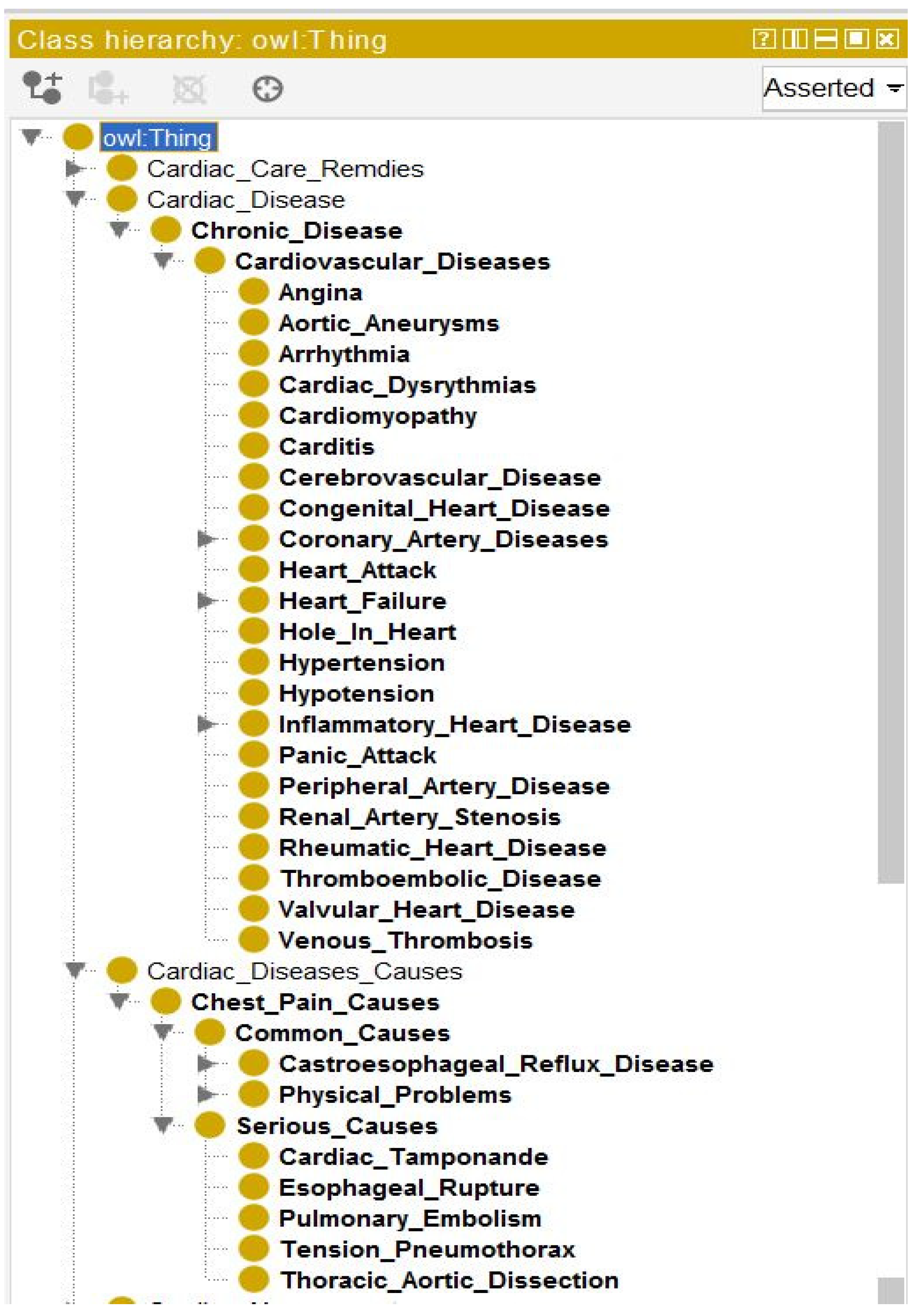
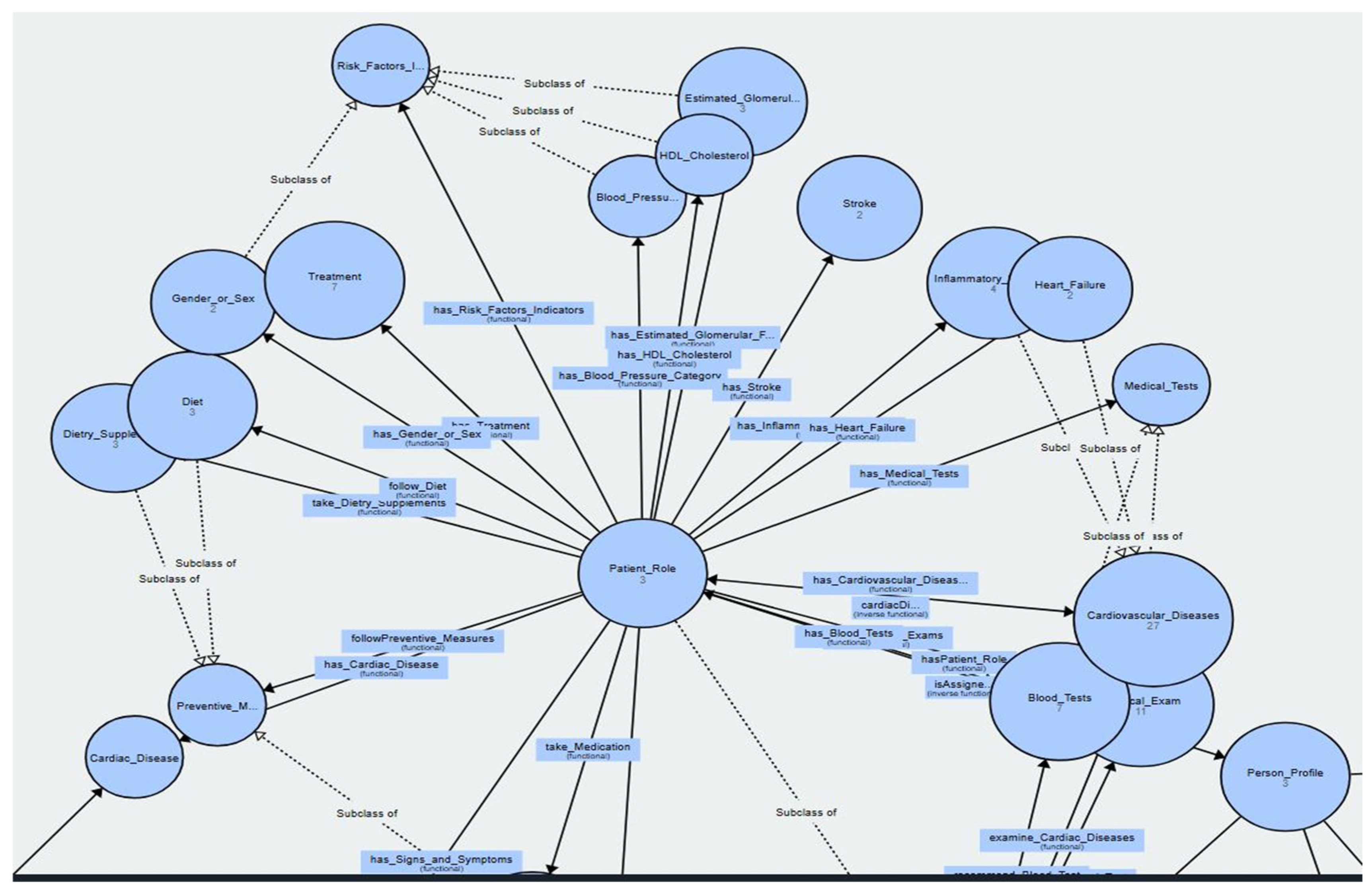

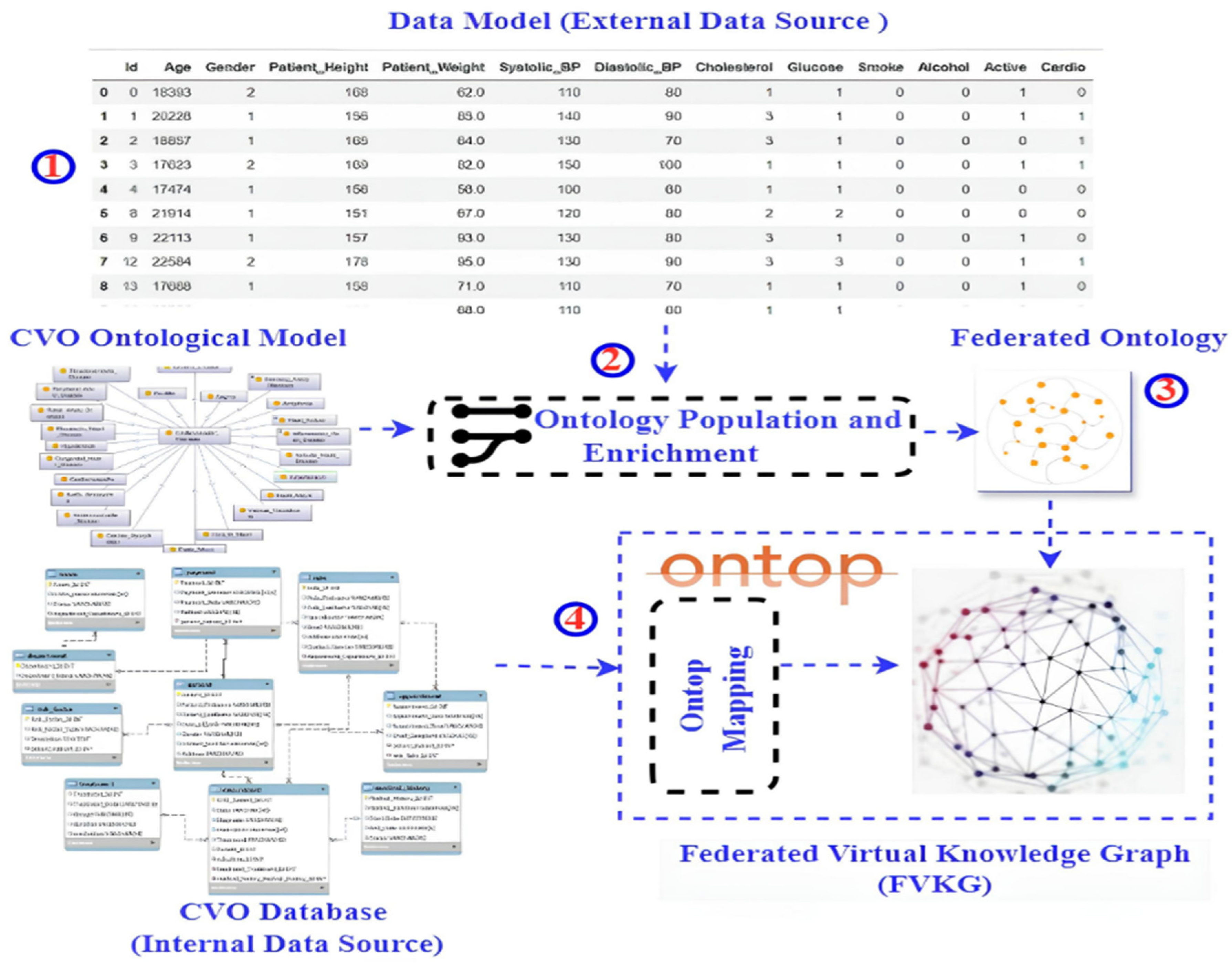

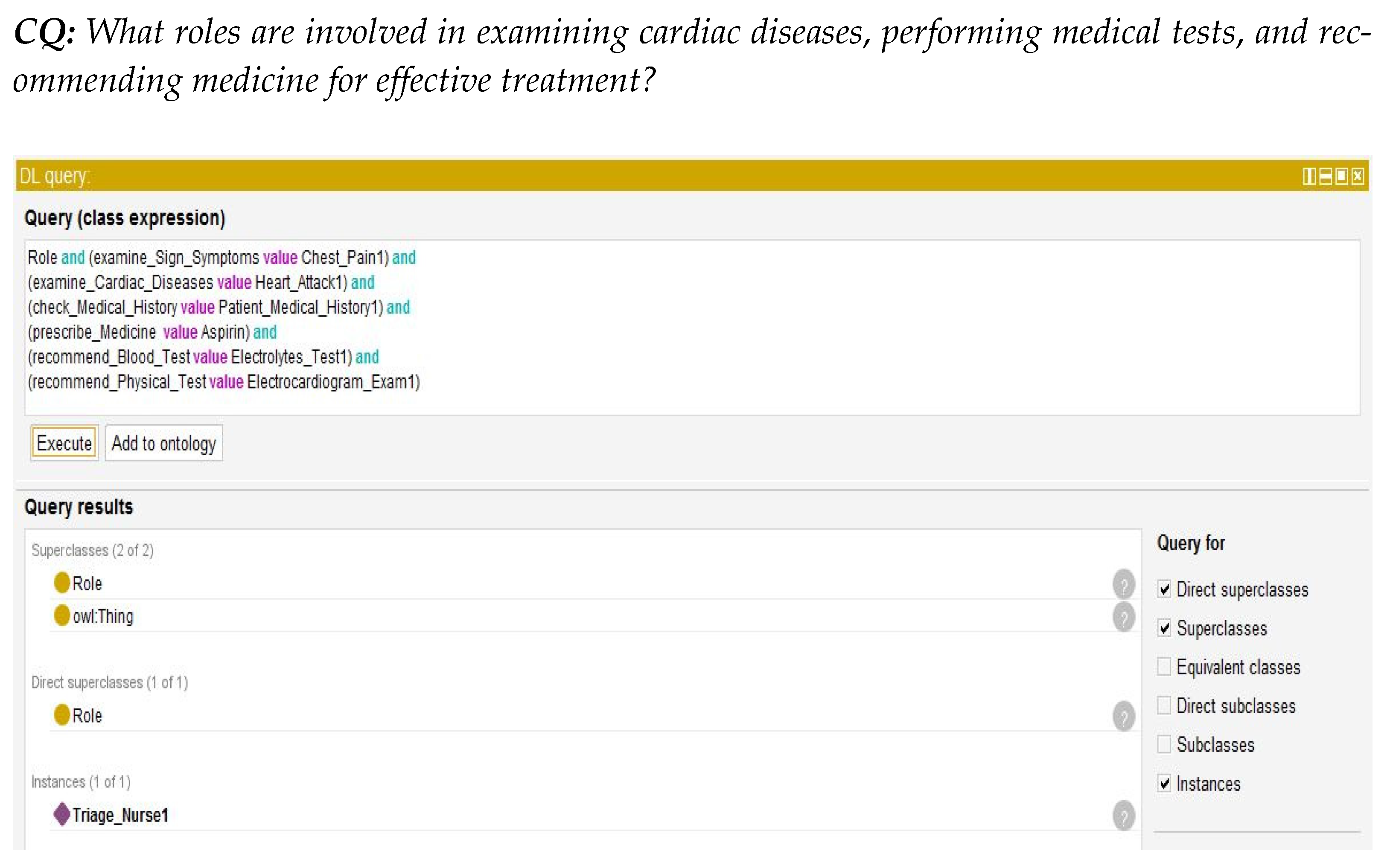
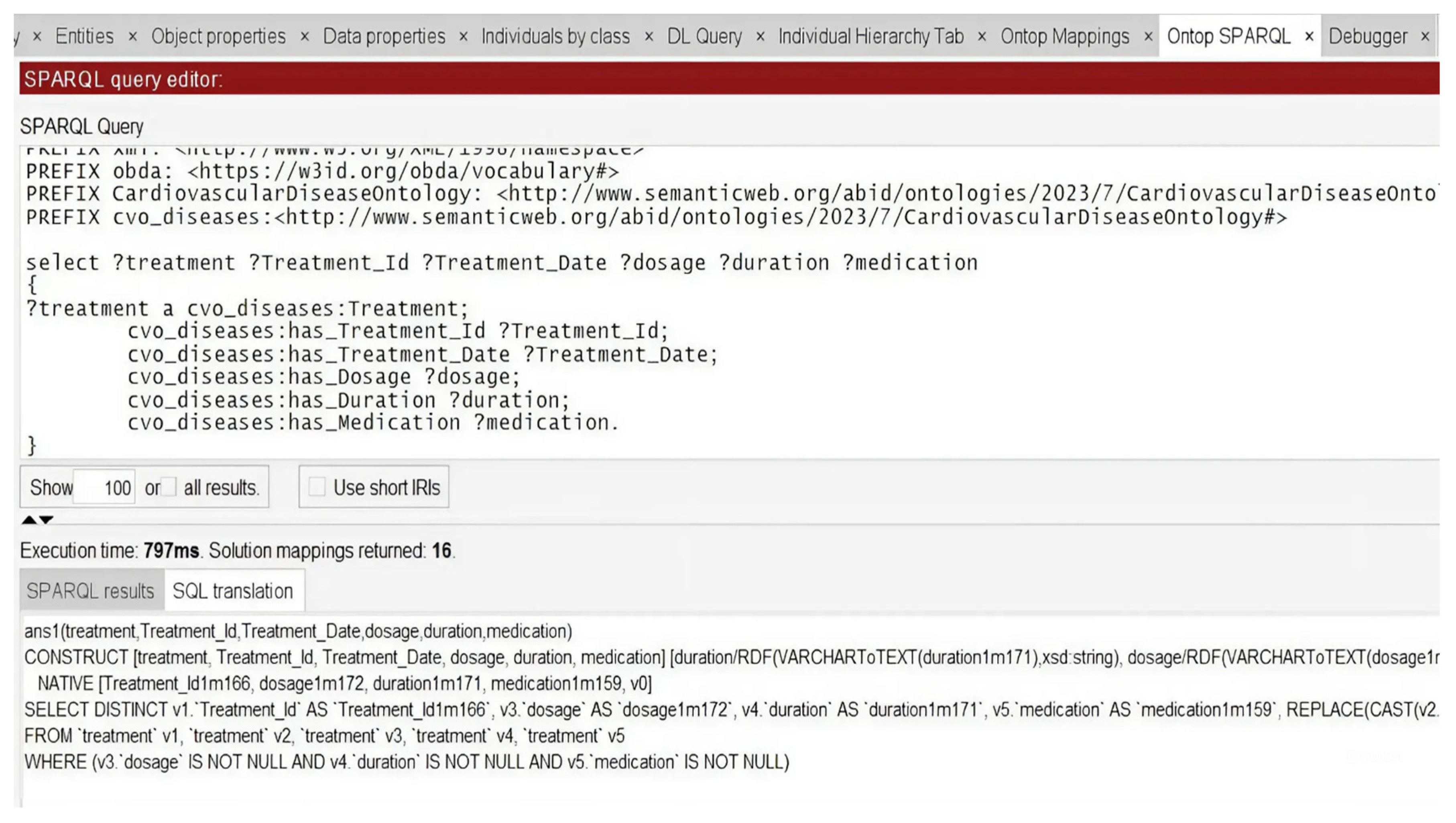

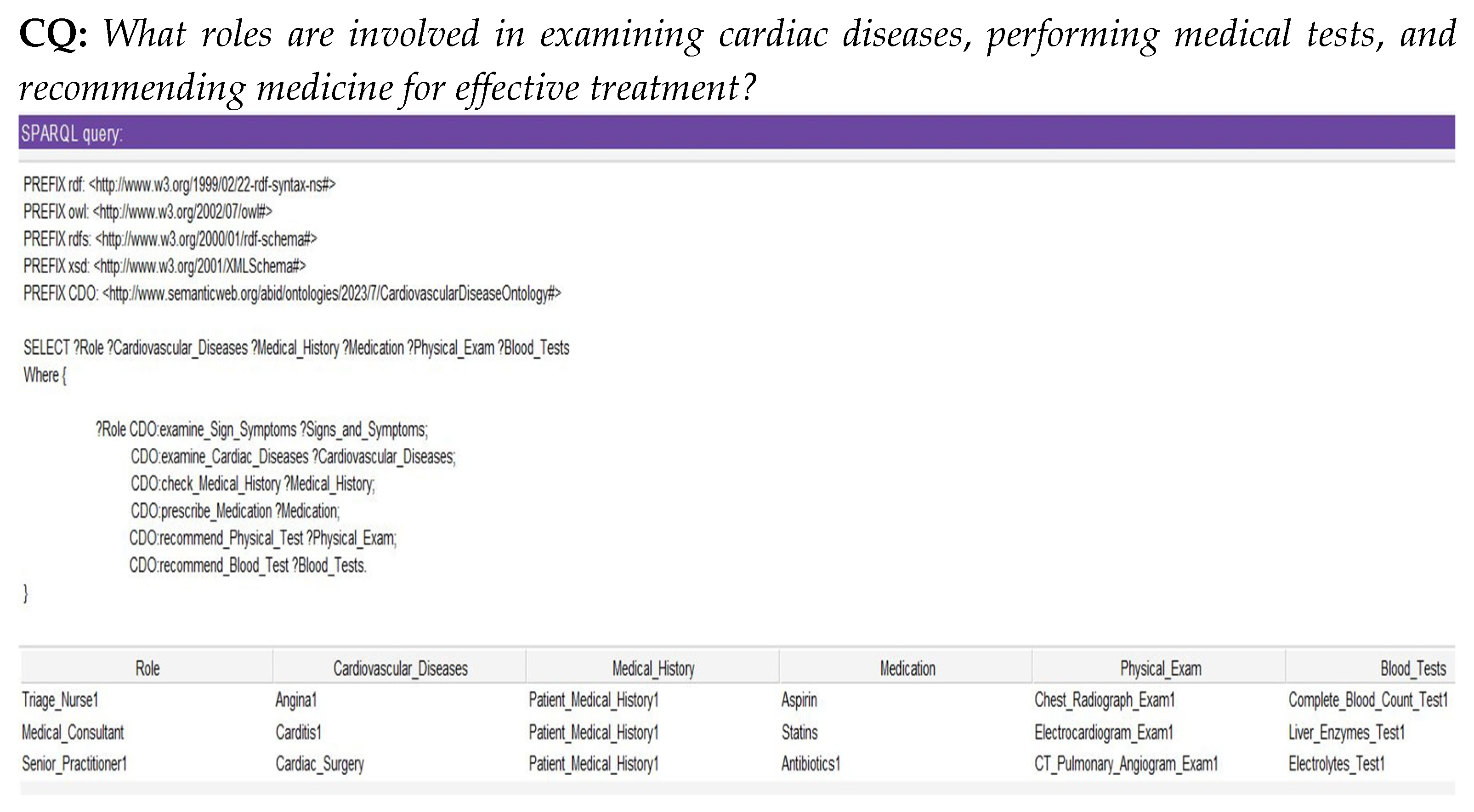
| Phases | Tasks | Outcomes |
|---|---|---|
| Knowledge stimulus (construct-level artifact) |
|
|
| Tacit knowledge modeling (neuronal-level artifact) |
|
|
| Architectural artifact of federated virtual knowledge graphs (FKVGs) |
|
|
| Conceptual modeling Symbolic-level artifact (explicit knowledge) |
|
|
| Deployment, evaluation, and testing |
|
|
| Mapping Rules |
| Rule 1: Tables in databases are to be associated with OWL classes in ontology file. Rule 2: Handling of bridge tables using constraint keys. Rule 3: Mapping of referential integrity relationships to inheritance hierarchy. Rule 4: Mapping of non-referential integrity columns into datatype properties. Rule 5: Represents data type properties in the host class as Domain (D) and data type as Range (R). Rule 6: Mapping relationships represented by referential integrity columns into object properties. Rule 7: Representation of object property host classes as D and R. Rule 8: All table records are mapped to individuals in ontology. Rule 9: Database column constraints are mapped into ontology property cardinalities [68]. |
| Prefix | |
| PREFIX owl: <http://www.w3.org/2002/07/owl#> PREFIX rdf: <http://www.w3.org/1999/02/22-rdf-syntax-ns#> PREFIX xml: <http://www.w3.org/XML/1998/namespace> PREFIX obda: <https://w3id.org/obda/vocabulary#> PREFIX CardiovascularDiseaseOntology: <http://www.semanticweb.org/abid/ontologies/2023/7/CardiovascularDiseaseOntology#> PREFIX cvo_diseases: <http://www.semanticweb.org/abid/ontologies/2023/7/CardiovascularDiseaseOntology#> | |
| Syntax of SPARQL Query | Mapping Query Generated by Ontop |
| select ?treatment ?Treatment_Id ?Treatment_Date ?dosage ?duration ?medication where { ?treatment a cvo_diseases:Treatment; cvo_diseases:has_Treatment_Id ?Treatment_Id; cvo_diseases:has_Treatment_Date ?Treatment_Date; cvo_diseases:has_Dosage ?dosage; cvo_diseases:has_Duration ?duration; cvo_diseases:has_Medication ?medication. } | :cvo_diseases/treatment/ a CardiovascularDiseaseOntology:Treatment; CardiovascularDiseaseOntology:has_Treatment_Id {Treatment_Id}^^xsd:integer; CardiovascularDiseaseOntology:has_Treatment_Date {Treatment_Date}^^xsd:dateTime; CardiovascularDiseaseOntology:has_Dosage {dosage}^^xsd:string; CardiovascularDiseaseOntology:has_Duration {duration}^^xsd:string; CardiovascularDiseaseOntology:has_Medication {medication}^^xsd:string. |
| select ?medical_history ?Medical_History_Id ?Medical_Condition ?Start_Date ?End_Date ?Status where { ?medical_history a cvo_diseases:Medical_Hisotry; cvo_diseases:has_Medical_History_Id ?Medical_History_Id; cvo_diseases:has_Medical_Condition ?Medical_Condition; cvo_diseases:has_Start_Date ?Start_Date; cvo_diseases:has_End_Date ?End_Date; cvo_diseases:has_Status ?Status. } | :cvo_diseases/medical_history/ a CardiovascularDiseaseOntology:Medical_History; CardiovascularDiseaseOntology:has_Medical_History_Id {Medical_History_Id}^^xsd:integer; CardiovascularDiseaseOntology:has_Medical_Condition {Medical_Condition}^^xsd:string; CardiovascularDiseaseOntology:has_Start_Date {Start_Date}^^xsd:dateTime; CardiovascularDiseaseOntology:has_End_Date {End_Date}^^xsd:dateTime; CardiovascularDiseaseOntology:has_Status {Status}^^xsd:string. |
| select ?role ?Role_Id ?Role_Firstname ?Role_Lastname ?Specialization ?Email ?Address ?Contact_Number where { ?role a cvo_diseases:Role; cvo_diseases:has_Role_Id ?Role_Id; cvo_diseases:has_Role_Firstname ?Role_Firstname; cvo_diseases:has_Role_Lastname ?Role_Lastname; cvo_diseases:has_Specialization ?Specialization; cvo_diseases:has_Email ?Email; cvo_diseases:has_Address ?Address; cvo_diseases:has_Contact_Number ?Contact_Number. (?Specialization=“Cardiologist”).} | :cvo_diseases/role/ a CardiovascularDiseaseOntology:Role; CardiovascularDiseaseOntology:has_Role_Id {Role_Id}^^xsd:integer; CardiovascularDiseaseOntology:has_Role_Firstname {Role_Firstname}^^xsd:string; CardiovascularDiseaseOntology:has_Role_Lastname {Role_Lastname}^^xsd:string; CardiovascularDiseaseOntology:has_Specialization {Specialization}^^xsd:string; CardiovascularDiseaseOntology:has_Email {Email}^^xsd:string; CardiovascularDiseaseOntology:has_Address {Address}^^xsd:string; CardiovascularDiseaseOntology:has_Contact_Number {Contact_Number}^^xsd:string. |
| Syntax | Query | Execution Time |
| PREFIX owl: <http://www.w3.org/2002/07/owl#> PREFIX rdf: <http://www.w3.org/1999/02/22-rdf-syntax-ns#> PREFIX xml: <http://www.w3.org/XML/1998/namespace> PREFIX obda: <https://w3id.org/obda/vocabulary#> PREFIX CardiovascularDiseaseOntology: <http://www.semanticweb.org/abid/ontologies/2023/7/CardiovascularDiseaseOntology#> PREFIX cvo_diseases: <http://www.semanticweb.org/abid/ontologies/2023/7/CardiovascularDiseaseOntology#> | ||
| Ontop Mapping | select ?treatment ?Treatment_Id ?Treatment_Date ?dosage ?duration ?medication where { ?treatment a cvo_diseases:Treatment; cvo_diseases:has_Treatment_Id ?Treatment_Id; cvo_diseases:has_Treatment_Date ?Treatment_Date; cvo_diseases:has_Dosage ?dosage; cvo_diseases:has_Duration ?duration; cvo_diseases:has_Medication ?medication. FILTER(?Treatment_Id=1)} | 34 ms |
| SQL Translation | SELECT DISTINCT v1.’Treatment_Id’ AS ‘Treatment_Id1m 177’, v3.‘dosage’ AS ‘dosage1m184’, v4.‘duration’ AS ‘duration1m183’, v5.‘medication’ AS ‘medication1m168’, REPLACE(CAST(v2.’Treatment_Date’ AS CHAR(30)),’ ‘, ‘T’) AS ‘v0’. FROM ‘treatment’ v1, ‘treatment’ v2, ‘treatment’ v3, ‘treatment’ v4, ‘treatment’ v5. WHERE ((v1.’Treatment_Id’ = 1) AND v3.’dosage’ IS NOT NULL AND v4.’duration’ IS NOT NULL AND v5.’medication’ IS NOT NULL) | 0.001806 ms |
| Ontop Mapping | select ?role ?Role_Id ?Role_Firstname ?Role_Lastname ?Specialization ?Email ?Address ?Contact_Number where { ?role a cvo_diseases:Role; cvo_diseases:has_Role_Id ?Role_Id; cvo_diseases:has_Role_Firstname ?Role_Firstname; cvo_diseases:has_Role_Lastname ?Role_Lastname; cvo_diseases:has_Specialization ?Specialization; cvo_diseases:has_Email ?Email; cvo_diseases:has_Address ?Address; cvo_diseases:has_Contact_Number ?Contact_Number. FILTER ((?Specialization)=“Cardiologist” && (?Role_Id=1) && (?Role_Firstname=“Mark”)).} | 72 ms |
| SQL Translation | SELECT DISTINCT v6.’Address’ AS ‘Address1m156’, v7.’Contact_Number’ AS ‘Contact_Number1m161’, v5.’Email’ AS ‘Email1m151’, v1.’Role_Id’ AS ‘Role_Id1m166’, v3.’Role_LastName’ AS ‘Role_LastName1m192’ FROM ‘role’ v1, ‘role’ v2, ‘role’ v3, ‘role’ v4, ‘role’ v5, ‘role’ v6, ‘role’ v7 WHERE ((v1.’Role_Id’ = 1) AND ‘Mark’ = v2.’Role_Firstname’ AND ‘Cardiologist’ = v4.‘Specialization’); | 0.00698 ms |
| Ontop Mapping | select ?medical_history ?Medical_History_Id ?Medical_Condition ?Start_Date ?End_Date ?Status where { ?medical_history a cvo_diseases:Medical_History; cvo_diseases:has_Medical_History_Id ?Medical_History_Id; cvo_diseases:has_Medical_Condition ?Medical_Condition; cvo_diseases:has_Start_Date ?Start_Date; cvo_diseases:has_End_Date ?End_Date; cvo_diseases:has_Status ?Status.} | 84 ms |
| SQL Translation | SELECT DISTINCT v2.’Medical_Condition’ AS ‘Medical_Condition1m159’, v1.’Medical_History_Id’ AS ‘Medical_History_Id1m191’, v5.’Status’ AS ‘Status1m172’, REPLACE(CAST(v4.’End_Date’ AS CHAR(30)),‘ ‘, ‘T’) AS ‘v0’, REPLACE(CAST(v3.’Start_Date’ AS CHAR(30)),‘ ‘, ‘T’) AS ‘v1’ FROM ‘medical_history’ v1, ‘medical_history’ v2, ‘medical_history’ v3, ‘medical_history’ v4, ‘medical_history’ v5; | 0.001806 ms |
Disclaimer/Publisher’s Note: The statements, opinions and data contained in all publications are solely those of the individual author(s) and contributor(s) and not of MDPI and/or the editor(s). MDPI and/or the editor(s) disclaim responsibility for any injury to people or property resulting from any ideas, methods, instructions or products referred to in the content. |
© 2025 by the authors. Licensee MDPI, Basel, Switzerland. This article is an open access article distributed under the terms and conditions of the Creative Commons Attribution (CC BY) license (https://creativecommons.org/licenses/by/4.0/).
Share and Cite
Fareedi, A.A.; Gagnon, S.; Ghazawneh, A.; Valverde, R. Semantic Fusion of Health Data: Implementing a Federated Virtualized Knowledge Graph Framework Leveraging Ontop System. Future Internet 2025, 17, 245. https://doi.org/10.3390/fi17060245
Fareedi AA, Gagnon S, Ghazawneh A, Valverde R. Semantic Fusion of Health Data: Implementing a Federated Virtualized Knowledge Graph Framework Leveraging Ontop System. Future Internet. 2025; 17(6):245. https://doi.org/10.3390/fi17060245
Chicago/Turabian StyleFareedi, Abid Ali, Stephane Gagnon, Ahmad Ghazawneh, and Raul Valverde. 2025. "Semantic Fusion of Health Data: Implementing a Federated Virtualized Knowledge Graph Framework Leveraging Ontop System" Future Internet 17, no. 6: 245. https://doi.org/10.3390/fi17060245
APA StyleFareedi, A. A., Gagnon, S., Ghazawneh, A., & Valverde, R. (2025). Semantic Fusion of Health Data: Implementing a Federated Virtualized Knowledge Graph Framework Leveraging Ontop System. Future Internet, 17(6), 245. https://doi.org/10.3390/fi17060245








